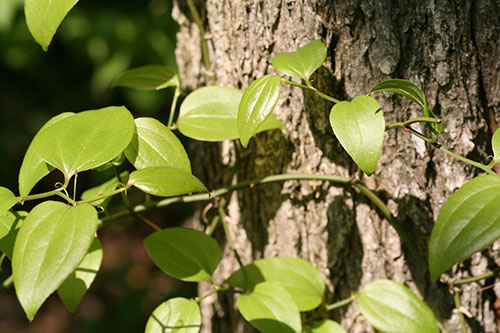Round-leaved Greenbrier

Species information
The following is a report on progress made towards the protection and recovery of Round-leaved Greenbrier (Smilax rotundifolia) in Ontario from 2007 to 2023, based on Ontario’s species-specific recovery policy. This report meets the legislative requirement for a review of progress under the Endangered Species Act, 2007 (ESA or “the Act”). Round-leaved Greenbrier is listed as threatened on the Species at Risk in Ontario (SARO) List under the ESA. Round-leaved Greenbrier has been classified as a species at risk since 1995. It was originally classified as vulnerable (in 1995), and then as threatened (in 2001), under the previous Endangered Species Act. It retained its “threatened” status under the ESA when it came into force in June 2008.
Round-leaved Greenbrier has been protected from being killed, harmed, harassed, captured or taken since 2008.
In addition, the habitat of Round-leaved Greenbrier has been protected from being damaged or destroyed since 2013.
The species-specific recovery policy for Round-leaved Greenbrier, known as the government response statement (GRS) was published in 2019 and includes the government’s recovery goal for the species and the actions and priorities it intends to lead or support to help achieve that goal. The GRS considers science advice provided in the recovery strategy (published in 2018), regarding things such as the species biology, habitat needs, threats to survival, knowledge gaps and approaches to recovery, when developing recovery actions for the species. As legislated in the Act, the purpose of this review is to report on progress made towards implementing the protection and recovery actions in the GRS. The review can also help identify opportunities to adjust and adapt the implementation of protection and recovery actions to achieve the recovery goal for the species.
Further information about Round-leaved Greenbrier, including the threats that it faces and actions being taken to help protect and recover this species, is available on the Government of Ontario webpage for Round-leaved Greenbrier. A summary on the progress towards the protection and recovery of Round-leaved Greenbrier and an annual update on the broader species at risk program (i.e. the Introduction to the 2024 Review of Progress report) is available on the Review of Progress towards the Protection and Recovery of Ontario’s Species at Risk webpage.
Snapshot: Progress towards the protection and recovery of Round-leaved Greenbrier
Progress towards meeting the recovery goal
- The recovery goal in the government response statement (GRS) for Round-leaved Greenbrier in Ontario is to “maintain the species’ distribution in Ontario, and to support the viability of natural populations by addressing threats and limitations. The government supports augmenting single-sex populations where feasible and investigating the necessity and feasibility of augmenting mixed-sex populations”.
- Progress has been made towards implementing the majority of government-led actions. Progress has been made towards implementing one of the government-supported recovery objectives and one of the associated actions. Examples of progress include:
- developing and implementing a monitoring program for Round-leaved Greenbrier that will evaluate detectability and survey locations where the population is considered to be historical, as well as investigating population dynamics such as genetics, reproductive biology, and factors inhibiting growth
- In alignment with the GRS, further work is required to:
- conduct research to determine optimal methods for managing Round-leaved Greenbrier populations
- collaborating with landowners and local agencies to implement, monitor and adapt actions to promote sexual reproduction in the species
- develop, implement and evaluate management plans and best management practices for Round-leaved Greenbrier habitat and viability
- promote awareness and implement approaches to avoid or reduce impacts of recreational activities on Round-leaved Greenbrier and its habitat
Occurrences and distribution
- Sixteen populations of Round-leaved Greenbrier have been documented in southern Ontario. Currently 14 of these populations
footnote 1 are extantfootnote 2 and the remaining 2 are considered historicalfootnote 3 . Since 2008, the status of 2 populations changed from extant to historical based on the date that it was last observed, while 5 populations of Round-leaved Greenbrier have been newly-identified since 2008.
Government-supported stewardship projects
- Through the Species at Risk Stewardship Program, the Government of Ontario has enabled its stewardship partners to conduct three projects (by providing $77,235 in funding) that have supported the protection and recovery of multiple species at risk, including Round-leaved Greenbrier. Two projects ($62,235) were designed to provide benefits to multiple species at risk (e.g., landscape-level habitat restoration, or outreach and education focusing on a certain group of species such as those present in a local region), while one project ($15,000) focused exclusively on Round-leaved Greenbrier.
- The government’s support helped its stewardship partners to involve many individuals who volunteered 7,174 hours of their time towards protection and recovery activities for species at risk, including Round-leaved Greenbrier. The estimated value of these voluntary contributions, as well as additional funding and in-kind support, is $167,082.
Supporting human activities while ensuring appropriate support for species recovery
- Thirty-six activities have been undertaken in accordance with a conditional exemption that requires registration under the ESA. The activities followed either the conditional exemption for ‘drainage works’ (section 23.9) or ‘threats to health and safety, not imminent’ (section 23.18) under Ontario Regulation 242/08 of the ESA.
Reporting on the progress towards the protection and recovery of Round-leaved Greenbrier
Recovery goal
The government’s goal for the recovery of Round-leaved Greenbrier is to maintain the species’ distribution in Ontario, and to support the viability of natural populations by addressing threats and limitations. The government supports augmenting single-sex populations where feasible and investigating the necessity and feasibility of augmenting mixed-sex populations.
The implementation of government-led and government-supported actions demonstrates progress towards reaching the desired objectives and the recovery goal set out in the GRS.
Progress towards implementing government-led actions
Progress has been made towards implementing the majority of government-led actions identified in the GRS. Common actions for the government to lead as it works towards achieving a species’ recovery goal include:
- Educate other agencies and authorities involved in planning and environmental assessment processes on the protection requirements under the ESA.
- Encourage the submission of Round-leaved Greenbrier data to Ontario’s central repository through the citizen science project that they receive data from (i.e., iNaturalist.ca) and directly through the Natural Heritage Information Centre.
- Undertake communications and outreach to increase public awareness of species at risk in Ontario.
- Continue to protect Round-leaved Greenbrier and its habitat through the ESA.
- Support conservation, agency, municipal and industry partners, and Indigenous communities and organizations to undertake activities to protect and recover Round-leaved Greenbrier. Support will be provided where appropriate through funding, agreements, permits (including conditions) and/or advisory services.
- Encourage collaboration and establish and communicate annual priority actions for government support in order to reduce duplication of efforts.
Additionally, the government has directly undertaken the following species-specific actions:
- continue to implement the Ontario Invasive Species Strategic Plan (2012) to address the invasive species (e.g., Garlic Mustard) that threaten Round-leaved Greenbrier
Key progress made towards implementing these actions is described in the following sections.
Invasive species in Ontario
The Government of Ontario is committed to continuing its efforts to prevent, detect, respond to and manage invasive species in order to reduce their harmful impacts in the province, including to species at risk and their habitats. The GRS for Round-leaved Greenbrier indicates that invasive plant species that compete with Round-leaved Greenbrier (e.g., Garlic Mustard (Alliaria petiolata) and Glossy Buckthorn (Frangula alnus)) pose a threat to the survival and recovery of this species in Ontario. The Government of Ontario continues to take action to advance the management of invasive species which could potentially harm the recovery of Round-leaved Greenbrier by working with partners to identify innovative solutions to control invasive plants. For example, tthrough annual funding agreements with the Invasive Species Centre, the Ministry of Natural Resources has been supporting collaborative efforts with the University of Toronto and federal partners to investigate a potential biological control agent for Garlic Mustard.
Occurrences and distribution
Tracking the occurrences and distribution of a species is a useful way to monitor and view where a species is found and how it is doing. Ontario’s Natural Heritage Information Centre (NHIC), the government’s central data repository, gathers and manages this type of biodiversity information. NHIC tracks and maps this data as species observations and individual element occurrences, where an element occurrence is an area of land and/or water where a species or plant community is or was present, and has a practical conservation value. For the purposes of this report, ‘population’ is an alternative name for element occurrence.
Sixteen populations of Round-leaved Greenbrier have been documented in Ontario. Fourteen are considered to be extant (i.e., observed within the past 20 years), and two are considered to be historical. The extant populations are located throughout southern Ontario with many in the Niagara region. Since 2008, the government’s central conservation data repository at the NHIC has received 145 records of the species. These records are based on observations made between 1882 and 2023 and have been submitted to NHIC from a variety of sources. Records submitted have helped to refine where the species is known and has been known to occur and can provide additional information on the species’ habitat and threats.
Five of the known extant populations – at Elgin County, Niagara and Niagara Falls, Mosa Forest, and Ashton Forest Conservation Area – have been discovered since 2008. Records for other populations have existed since the 1980’s. In contrast, two populations that were previously considered extant in 2008 are now considered historical, since no observations were reported in over 20 years.
The newly identified local populations are the likely result of increased search effort and education about Round-leaved Greenbrier and may not represent actual population increases, but rather increased knowledge about the distribution of the species.
It is possible that there are observations of Round-leaved Greenbrier that have not been submitted to the government. Encouraging the submission of observations of this species is included in the GRS as a government-led action. Submission of species observations increases our knowledge of where they occur and can play an important role in assessing the viability of species populations.
Everyone is encouraged, or may be required by an authorization or condition of a regulatory exemption, to submit observations of Round-leaved Greenbrier, and any other species at risk observed, to the NHIC for incorporation into the provincial record of observations.
- 145observations of this species were submitted to the NHIC since 2008
Government-supported stewardship projects
An important government-led action in the GRS for Round-leaved Greenbrier is to support partners to undertake activities to protect and recover the species. Through the Species at Risk Stewardship Program the government has supported three projects ($77,235) designed to contribute to the protection and recovery of Round-leaved Greenbrier. Two of these projects ($62,235) were designed to provide benefits to multiple species at risk (e.g., landscape-level habitat restoration or, outreach and education focussing on a certain group of species such as those present in a local region), including Round-leaved Greenbrier, while one project ($15,000) focused exclusively on Round-leaved Greenbrier.
In addition to the government funding, partners focusing exclusively on Round-leaved Greenbrier reported they were successful in securing additional funding ($11,850) from other sources, as did partners with projects designed to benefit multiple species at risk, including Round-leaved Greenbrier ($155,232). These amounts include in-kind support in the form of time and expertise provided by volunteers.
Stewardship partners reported that provincial funding helped them to secure in-kind support by involving three individuals who volunteered 40 hours of their time towards protection and recovery activities that focused exclusively on Round-leaved Greenbrier, which has an estimated value of $8,500. As well, individuals volunteered 7,134 hours of their time towards protection and recovery activities for multiple species at risk, including Round-leaved Greenbrier, which has an estimated value of $71,900.
The remainder of this section highlights a project supported through the Species at Risk Stewardship Program as well as the corresponding government-supported recovery actions for the species.
In 2017 Blue Oak Native Landscapes carried out a series of surveys in the Carolinian Zone of Ontario to update information on known populations of Round-leaved Greenbrier and to try to find new populations where possible. Eighteen stations representing 77 sub-populations were documented detailing their dimensions, sex, whether flowering or fruiting, approximate number of stems in stand, and habitat information. Major threats were identified including habitat loss, habitat encroachment, shading, deer browse, and invasive species. Using this information, recommendations on how to aid these populations and how to re-populate historical populations were developed. This project demonstrates progress towards the high priority action of developing and implementing a monitoring program for Round-leaved Greenbrier.
 2
2projects including Round-leaved Greenbrier
 1
1project for Round-leaved Greenbrier exclusively
 $77,235
$77,235for projects that included Round-leaved Greenbrier
 $167,082
$167,082in additional funding and in-kind support
 3
3volunteers
 40
40volunteer hours
Supporting human activities while ensuring appropriate support for species recovery
Supporting partners through authorizations and their associated conditions is an important government-led action. To date, no permits have been issued for Round-leaved Greenbrier. Thirty-six activities that may affect Round-leaved Greenbrier or its habitat have been registered for the purposes of Ontario Regulation 242/08: ‘General’ under the ESA. Five activities were registered under ‘drainage works’ (section 23.9), and 31 activities were registered under ‘threats to human health and safety, not imminent’ (section 23.18). These registrations require the registrant to comply with all conditions of the regulation, such as:
- giving the Ministry of the Environment, Conservation and Parks notice of the activity before it commences
- having a mitigation plan prepared by a person with expertise on Round-leaved Greenbrier to facilitate avoidance or minimization of adverse effects on Round-leaved Greenbrier while the activity is carried out
- taking reasonable steps to minimize adverse effects on Round-leaved Greenbrier while carrying out the activity
- 36registrations
Progress towards implementing government-supported actions
Government-supported actions are organized under overarching recovery objectives. Progress has been made towards achieving one government-supported recovery objective and implementing one of the associated actions identified in the GRS for Round-leaved Greenbrier.
Objective: Increase knowledge of the distribution, abundance, population composition, and habitat conditions of Round-leaved Greenbrier in Ontario:
- Action No. 1 (High Priority) – Develop and implement a monitoring program for Round-leaved Greenbrier. The program should be designed and implemented in such a manner that it may contribute to research actions and including the following:
- evaluate detectability of Round-leaved Greenbrier and survey locations where the population is considered to be historical
- investigate population dynamics including genetics, reproductive biology, recruitment, and factors inhibiting growth
Under this objective, considerable progress has been made towards implementing Action No. 1 (High Priority) through the project supported by the Species at Risk Stewardship Program, particularly in evaluating detectability and survey locations in both new and historical locations as well as investigating factors inhibiting growth.
Summary of progress towards meeting the recovery goal
The recovery goal for Round-leaved Greenbrier is “to maintain the species’ distribution in Ontario, and to support the viability of natural populations by addressing threats and limitations. The government supports augmenting single-sex populations where feasible and investigating the necessity and feasibility of augmenting mixed-sex populations”. Effort made towards the government-led and government-supported actions has helped to make progress towards this goal. For example, one stewardship project has developed and implemented a monitoring program in both new and historical survey locations which has produced updated information about the status of extant populations.
Recommendations
As stated in the GRS, this review of progress can be used to help identify whether adjustments to the implementation of GRS actions are needed, to achieve the protection and recovery of the species. Based on progress to date, the overall direction provided in the GRS for Round-leaved Greenbrier, particularly the implementation of actions identified as high priority, should continue to guide protection and recovery of the species.
More specifically, further research is required to determine optimal methods for managing both single-sex and mixed-sex Round-leaved Greenbrier populations and investigating if a sex ratio bias is present. Another area of emphasis going forward is on collaborative efforts with landowners, land managers, and local agencies to promote sexual reproduction in the species, and to develop and implement management plans and best management practices for both habitat quality and population viability. Lastly, efforts directed towards working with community partners and local landowners to avoid or reduce the impact of recreational activities and to promote awareness about Round-leaved Greenbrier among land users and land managers also remain priorities going forward.
Protecting and recovering Round-leaved Greenbrier will continue to be a shared responsibility that will require the involvement of many individuals, organizations and communities. Financial support for the implementation of actions may be available through the Species at Risk Stewardship Program. The government can also advise if any authorizations under the ESA or other legislation may be required to undertake a project. By working together, progress can continue to be made towards protecting and recovering Round-leaved Greenbrier in Ontario.
Footnotes
- footnote[1] Back to paragraph For the purposes of this report, a population is an alternative name for an element occurrence which is defined as an area of land and/or water on/in which an element (e.g., a species) is or was present. A population record is based on one or more observations and the area has a practical conservation value as it is important to the conservation of the species.
- footnote[2] Back to paragraph A population is considered extant if it has been observed within the last 20 years or an appropriate interval for the species in question. Extant populations may have been extirpated, particularly if observations are not recent and updated information is unavailable.
- footnote[3] Back to paragraph A population is considered historical if it has not been recorded within the last 20 years. Historical populations may still exist, but updated information is not available.